| Listing 1 - 8 of 8 |
Sort by
|
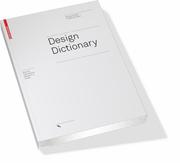
ISBN: 9783764377397 9783764377380 Year: 2008 Publisher: Berlin Birkhäuser
Abstract | Keywords | Export | Availability | Bookmark
 Loading...
Loading...Choose an application
- Reference Manager
- EndNote
- RefWorks (Direct export to RefWorks)
Design --- Dictionaries --- Dictionnaires anglais --- 745.01 --- designtheorie --- woordenboeken --- terminologie --- designfilosofie en -theorie --- EPUB-LIV-FT LIVARCHI SPRINGER-B
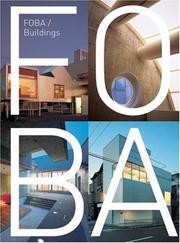
ISBN: 1568985274 9786611042806 1281042803 1568986351 Year: 2005 Publisher: New York, NY : Princeton Archit.Press : Imprint: Princeton Architectural Press,
Abstract | Keywords | Export | Availability | Bookmark
 Loading...
Loading...Choose an application
- Reference Manager
- EndNote
- RefWorks (Direct export to RefWorks)
Pure. Minimal. Simple. These are the words commonly used to describe the work of contemporary Japanese architects. FOBA, an internationally celebrated architectural practice based in Kyoto, looks beyond the aesthetics of minimalism, instead finding inspiration in the relationships between structure and site. ""FOBA: Buildings,"" the first monograph on the decade-old firm, features ten projects of surprising range: undulating lines, overlapping cubes, interpenetrating forms, and unexpected pairings demonstrate a varied set of approaches to projects. The work is at times boldly expressionistic,
Architecture --- History --- Histoire --- Umebayashi, Katsu, --- FOBA (Firm) --- Architecture -- Japan -- History -- 20th century. --- FOBA (Firm). --- Umebayashi, Katsu, 1963-. --- Art, Architecture & Applied Arts --- EPUB-LIV-FT LIVARCHI SPRINGER-B --- Architecture, Modern --- Architecture. --- Architects. --- Architecture / Design. --- Professional employees
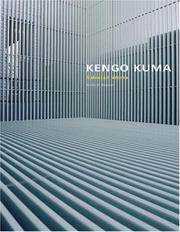
ISBN: 1568984596 9781568984599 1568984685 9786611141721 1281141720 1568986424 9781568984681 Year: 2006 Publisher: New York (N.Y.) Princeton architectural press
Abstract | Keywords | Export | Availability | Bookmark
 Loading...
Loading...Choose an application
- Reference Manager
- EndNote
- RefWorks (Direct export to RefWorks)
Evanescent Restrained. Ethereal. These are some of the words used to describe the architecture of Kengo Kuma, one of the most heralded of a new generation of Japanese architects. A recent article in ""Architecture writes of Kuma that ""he strives to give his buildings the qualities of a rainbow, composed of shimmering particles, more illusion than object that change as you look at them."" Increasingly the focus of international renown, Kuma's work is characterized by a delicate simplicity and minimalism, incorporating a wide range of ephemeral transparencies. Their ineffable vibrancy is achiev
Kuma, Kengo --- Kuma, Kengo, --- Architecture -- Japan -- History -- 20th century. --- Kuma, Kengo, 1954-. --- EPUB-LIV-FT LIVARCHI SPRINGER-B --- 隈研吾, --- 隈硏吾, --- Architecture. --- Architects. --- Architecture / Design. --- Architecture --- History --- Professional employees --- Architecture, Western (Western countries) --- Building design --- Buildings --- Construction --- Western architecture (Western countries) --- Art --- Building --- Design and construction --- Architecture, Modern --- Architecte --- Architecture contemporaine --- Eau --- Lumière --- Musée --- Verre --- Japon --- Histoire --- 隈研吾 --- Kuma, Kengo, 1954 --- -Japon
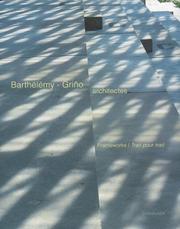
ISBN: 9783764372682 3764372680 9786611349264 1281349267 3764376538 Year: 2005 Publisher: Basel : Birkhauser,
Abstract | Keywords | Export | Availability | Bookmark
 Loading...
Loading...Choose an application
- Reference Manager
- EndNote
- RefWorks (Direct export to RefWorks)
Philippe Barthélémy and Sylvia Griño have been projecting buildings in France, Great Britain, Germany, Greece, Iceland, Brazil and the Far East for more than 20 years. Amongst their most prominent projects are a number of boutiques for Louis Vuitton. This book documents their most significant projects. Philippe Barthélémy from France and Sylvia Griño from Uruguay have been projecting buildings in France, Great Britain, Germany, Greece, Iceland, Brazil and the Far East for more than 20 years. Amongst their most prominent projects are a number of boutiques for the designer of luxury gifts and accessories, Louis Vuitton, in Germany, Taiwan, Thailand, Japan, South Korea and Brazil. In addition to other awards, Barthélémy-Griño were nominated for Le Moniteur's renowned Equerre d'argent prize for their sports centre in Nanterre with its innovative wood construction. This book documents in detail the most significant projects from Barthélémy-Griño. Der Franzose Philippe Barthélémy und die Uruguayerin Sylvia Griño realisieren seit rund 20 Jahren zahlreiche Bauten in Frankreich, Großbritannien, Deutschland, Griechenland, Island, Brasilien und verschiedenen fernöstlichen Ländern. Zu ihren prominentesten Projekten gehören diverse Läden für den Luxusprodukthersteller Louis Vuitton in Deutschland, Taiwan, Thailand, Japan, Süd-Korea und Brasilien. Neben verschiedenen anderen Preisen wurden Barthélémy und Griño auch für den renommierten Equerre d'argent-Preis nominiert (für das Sportzentrum in Nanterre mit seiner innovativen Holzkonstruktion), die wichtigste Architekturauszeichnung Frankreichs. Das Buch dokumentiert ausführlich die wichtigsten Projekte von Barthélémy-Griño.
Architecture --- History --- Histoire --- Barthélémy, Philippe, --- Griño, Sylvia, --- Barthélémy-Griño architectes. --- Architectural firms -- France. --- Architecture -- France -- History -- 20th century. --- Architecture -- France -- History -- 21st century. --- Barthe ́le ́my, Philippe, 1955-. --- Barthe ́le ́my-Grin~o architectes. --- Grin~o, Sylvia, 1957-. --- Art, Architecture & Applied Arts --- Architectural firms --- Barthélémy, Philippe, --- Griño, Sylvia, --- Barthélémy-Griño architectes. --- EPUB-LIV-FT LIVARCHI SPRINGER-B --- Architecture, Western (Western countries) --- Building design --- Buildings --- Construction --- Western architecture (Western countries) --- Art --- Building --- Firms, Architectural --- Architects --- Business enterprises --- Design and construction --- Architecture, Primitive --- Barthélémy & Griño architectes --- Barthelemy, Philippe, --- Grino, Sylvia,

ISBN: 1568985479 Year: 2006 Volume: 27 Publisher: New York : Princeton Architectural Press,
Abstract | Keywords | Export | Availability | Bookmark
 Loading...
Loading...Choose an application
- Reference Manager
- EndNote
- RefWorks (Direct export to RefWorks)
The latest instalment in the renowned Pamphlet Architecture series features the technologically progressive young firm Aranda/Lasch, illustrating their use of advanced computational methods and algorithmic code in architectural design. Tooling is broken down into seven sections: blending, cracking, flocking, losing, packing, spiralling, and weaving, each corresponding to a pattern generated by computer codes, which in turn creates an organizational template for putting projects together - from building materials to large-scale populations. Each section is broken down through a simple recipe th
Architectural design --- Architecture --- 72.012/013 --- Architectuur en digitale technieken ; digitale ontwerpen --- Computer Aided Design ; CAD --- Architectuurontwerpen ; computersimulaties ; B. Aranda ; Chr. Lasch --- 72.013 --- Architecture, Primitive --- Architecture, Western (Western countries) --- Building design --- Buildings --- Construction --- Western architecture (Western countries) --- Art --- Building --- Design --- Structural design --- Computer simulation --- Computer-aided design --- CAAD --- Architectonisch ontwerp --- Architectuurontwerp --- Computer aided architectural design --- Digitale architectuur --- Ontwerp (architectuur) --- Architectuur ; proportie, symmetrie, harmonie --- Design and construction --- Architectural design. --- Design architectural --- Architecture. --- Simulation par ordinateur. --- Conception assistée par ordinateur. --- Computer simulation. --- Computer-aided design. --- Simulation par ordinateur --- Conception assistée par ordinateur --- EPUB-LIV-FT LIVARCHI SPRINGER-B --- Conception assistée par ordinateur.
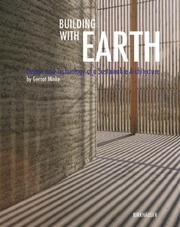

ISBN: 1281137499 9786611137496 3764378735 3764374772 9783764374778 Year: 2006 Publisher: Basel Birkhäuser
Abstract | Keywords | Export | Availability | Bookmark
 Loading...
Loading...Choose an application
- Reference Manager
- EndNote
- RefWorks (Direct export to RefWorks)
Der ressourcenschonende und gesunde Baustoff Lehm, seit Jahrtausenden gebräuchlich, erfreut sich seit vielen Jahren auch in den Industrienationen wachsender Beliebtheit. In gemäßigten und trocken-heißen Klimazonen bietet der Lehm zahlreiche Vorteile gegenüber anderen Materialien. Seine spezifische Beschaffenheit und Textur ist außerdem von hohem ästhetischem Reiz. Dieses Handbuchs bietet einen praxisorientierten systematischen Überblick über die zahlreichen Einsatzmöglichkeiten und Verarbeitungstechniken von Lehm; seine Eigenschaften und physikalischen Gegebenheiten werden detailliert und kenntnisreich erläutert. Die reichhaltigen Erfahrungen, die der Autor bei der Ausführung von Lehmbauten im In- und Ausland über 30 Jahre gewinnen konnte, spiegeln sich in seiner Darstellung wieder. Zahlreiche Baustellenfotos und Zeichnungen zeigen die konkrete Umsetzung von Lehm-Architektur. For a number of years, the healthy and environment-friendly building material earth, in common use for thousands of years, has been enjoying increasing popularity, including in industrialized nations. In hot dry and temperate climate zones, earth offers numerous advantages over other materials. Its particular texture and composition also holds great aesthetic appeal. The author's presentation reflects the rich and varied experiences gained over thirty years of building earth structures all over the world. Numerous photographs of construction sites and drawings show the concrete execution of earth architecture.
Earth construction. --- Sustainable buildings --- Sustainable architecture. --- Buildings --- Design and construction. --- Environmental engineering. --- Constructions durables --- Architectuur ; leem ; ongebakken aarde ; klei ; hanboeken --- Bouwmaterialen ; leem --- Bouwmaterialen ; leem, klei, aardewerk --- EPUB-LIV-FT LIVARCHI SPRINGER-B --- Duurzame architectuur --- Ecologisch bouwen --- 691.4 --- Earth construction --- Sustainable architecture --- Ecologically sustainable design (Buildings) --- Environmentally sustainable design (Buildings) --- ESD design (Buildings) --- Green building design --- Green design (Buildings) --- Sustainable design (Buildings) --- Eco-architecture --- Environmentally conscious architecture --- Environmentally friendly architecture --- Green architecture --- Architecture --- Sustainable design --- Building, Earth --- Earth building --- Building --- Environmental engineering (Buildings) --- Environmental engineering --- Sanitary engineering --- Design and construction --- Human factors --- Architectuur ; leem ; ongebakken aarde ; klei ; handboeken --- Construction en terre --- Architecture durable --- Constructions --- Conception et construction --- Technique de l'environnement
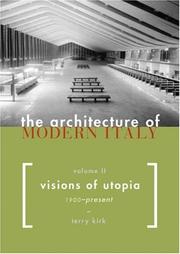
ISBN: 1568984383 1568984200 1568984367 Year: 2005 Publisher: New York Monacelli
Abstract | Keywords | Export | Availability | Bookmark
 Loading...
Loading...Choose an application
- Reference Manager
- EndNote
- RefWorks (Direct export to RefWorks)
Architecture --- Italy --- Architecture [Modern ] --- Architecture, Modern. --- Architecture moderne --- EPUB-LIV-FT LIVARCHI SPRINGER-B --- Architecture, Modern --- 72.035 --- 72.036 --- 72.03 --- 72.034 <45> --- 72.035 <45> 2 --- 72.036 <45> --- 72.036 <45> Moderne bouwkunst. Architectuur van de 20e eeuw--Italië --- Moderne bouwkunst. Architectuur van de 20e eeuw--Italië --- 72.034 <45> Architectuur van de renaissance; barok; rococo en koloniale stijl--Italië --- Architectuur van de renaissance; barok; rococo en koloniale stijl--Italië --- 72.035 <45> 2 Oude bouwstijlen in de 19e eeuw. Post-renaissance in de architectuur--Italië--Godsdienst. Theologie --- Oude bouwstijlen in de 19e eeuw. Post-renaissance in de architectuur--Italië--Godsdienst. Theologie --- Architecture, Italian --- Gruppo 7 (Group of architects) --- Modern architecture --- 19de eeuw (architectuur) --- Negentiende eeuw (architectuur) --- 20ste eeuw (architectuur) --- Twintigste eeuw (architectuur) --- Architectuur (geschiedenis) --- Architectuurgeschiedenis --- Architectuur ; Italië ; geschiedenis --- Architectuur ; Italië ; 20ste eeuw --- Architectuur ; Italië ; geschiedenis --- Architectuur ; Italië ; 20ste eeuw
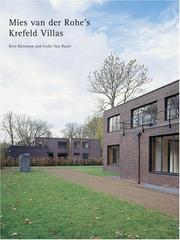
ISBN: 1568985037 9781568985039 Year: 2005 Publisher: New York Monacelli
Abstract | Keywords | Export | Availability | Bookmark
 Loading...
Loading...Choose an application
- Reference Manager
- EndNote
- RefWorks (Direct export to RefWorks)
Notes on Almost Nothing Haus Lange and Haus Esters did not make Mies van der Rohe famous. One might even say that the two neighboring brick villas in Krefeld, Germany (1927–30) have long been treated as a threat to Mies’s legacy: doubly damning evidence ?rst repressed by the architect himself and subsequently suppressed by his apologists. The history of this neglect is in its own right revealing, for to make two substantial buildings essentially disappear suggests a remarkable degree of consensus between the architect and his critics. [2, 3] Mies, as we know, said little about much, but particularly little was said about Haus Lange and Haus Esters. The architect proffered his only known assessment of the villas in a public dialogue at the Architectural Association in 1959. With thirty years of hindsight, Mies made his fateful condemnation: “I wanted to make this house [Haus Lange] much more in glass, but the client did not like that. I had great 1 trouble. ” This single remark—often published in tandem with an early pastel sketch of Haus Esters depicting a generously glazed garden facade or a photograph of the architect at work on the same—has been repeatedly cited to explain away these “compromised” works as the result of dif?cult clients.
Private houses --- villas --- architecture [object genre] --- architects --- Mies van der Rohe, Ludwig --- Krefeld --- Architecture, Domestic --- Architecture --- 72 --- Krefeld Villas --- Museum Haus Esters --- Museum Haus Lange Krefeld --- Nordrhein-Westfalen --- 72.038 --- 72.07 --- Architectuur ; Krefeld ; 20ste eeuw ; L. Mies van der Rohe --- Architectuur ; modernisme --- Mies van der Rohe, Ludwig 1886-1969 (°Aken, Duitsland) --- Woningbouw ; Krefeld villas's ; Haus Lange ; Haus Esters --- Architecture, Rural --- Domestic architecture --- Home design --- Houses --- One-family houses --- Residences --- Rural architecture --- Villas --- Dwellings --- Architecture, Western (Western countries) --- Building design --- Buildings --- Construction --- Western architecture (Western countries) --- Art --- Building --- History --- Architectuur --- Architectuurgeschiedenis ; 1950 - 2000 --- Architecten. Stedenbouwkundigen A - Z --- Design and construction --- Mies van der Rohe, Ludwig, --- Mies, Ludwig, --- Mis van der Roė, Li︠u︡dvig, --- Rohe, Ludwig Mies van der, --- Rohe, Mies van der, --- Van der Rohe, Ludwig Mies, --- Misi Fan De Luo, --- Criticism and interpretation. --- Museum Haus Esters. --- Museum Haus Lange Krefeld. --- Museum Haus Lange in Krefeld --- Kunstmuseum der Stadt Krefeld --- Museum Haus Lange (Krefeld, Germany) --- Krefeld (Germany). --- Museum Haus Lange, Krefeld --- Haus Lange (Krefeld, Germany) --- Museum Haus Esters Krefeld (Germany) --- Haus Esters (Krefeld, Germany) --- Krefeld (Germany) --- Crefeld (Germany) --- Krefeld, Ger. --- Krefeld-Uerdingen (Germany) --- Uerdingen am Rhein (Germany) --- Buildings, structures, etc. --- Architecture domestique --- Histoire --- Krefeld (Allemagne) --- Constructions. --- EPUB-LIV-FT LIVARCHI SPRINGER-B --- Architecture, Primitive
| Listing 1 - 8 of 8 |
Sort by
|

 Search
Search Feedback
Feedback About UniCat
About UniCat  Help
Help News
News